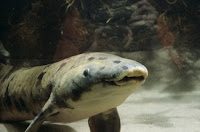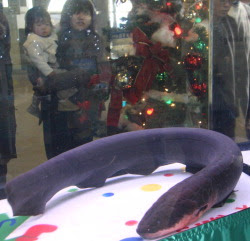Most of you have probably heard of the Horse Whisperer, and some of you are familiar with the dog whisperer as well. How about the Coral Whisperer? While he may never get a movie made about him, or his own cable television show, Mitch Carl of the Henry Doorly Zoo in Omaha Nebraska is being recognized for his ability to successfully raise Elkhorn Corals in captivity. I came across an article posted on the Omaha World Review website dubbing Mitch Carl as “The Coral Whisperer” for his ability to raise corals from wild captured eggs and sperm, where many others have had less success.
As part of an international research project which is studying sexual coral reproduction (SECORE), Carl and the Henry Doorly Zoo were one of many facilities that took part in the ongoing project, and received wild harvested Elkhorn coral eggs and sperm to try and raise in captivity. According to the article, 500,000 embryos were collected and distributed, of those only 1,100 were still alive after 3 months; these were Mitch Carl’s corals. As techniques have improved in subsequent harvests, survival rates have dramatically increased since the initial collection. Last year Carl was able to keep 75% on his embryos alive, other facilities involved in the project were still unable to achieve more than a 50% success rate. This is where the legend of the Coral whisperer comes from.
This project is of significance because of the coral species at the heart of the project. Elkhorn Coral is vital to natural reef systems throughout the world. It is not only one of the skeleton building corals that build foundations of the world reefs. The heavily branching Elkhorn coral provides habitat for many fish and other animals, as well as providing shorelines with a barrier from storm and wave action. Some estimates put destruction of the worlds Elkhorn Coral, mostly from human related activities, as high as 90%, and Elkhorn Coral is now an endangered species.
Most coral farming is done using asexual reproduction or cloning, taking small pieces or “frags” from a parent colony and allowing it to grow. This process is repeated time after time, and results in many copies of the original. Coral Farming using this “fraging” method produces coral that is adapted to captive environments, and thrives in aquarium conditions. This process works well for corals that are intended for aquarium or zoo use; however it is not a good method of reproduction for coral that is for reintroduction to the wild. These corals have been in captivity for many generations, and have adapted for unnatural conditions. Asexual reproduction is slow, and there is also the risk of introducing unwanted elements back into natural habitats.
Researchers hope that a viable sexual reproduction strategy can be reached, this will allow for “wild” corals to be grown in captivity in huge numbers, then be reintroduced back to the reefs where the eggs and sperm were collected. The hope is that these corals can be grown in coastal regions, where the eggs were collected, so that conditions can be matched as closely as possible to where they will be “planted” on the reef. Successful sexual reproduction of corals would also be of great value to the aquarium trade, the more captive raised corals become available, the less impact the hobby will have on natural reefs, as well as potentially lowering cost with the ability to mass produce corals sexually.
I hope you enjoyed this story. You can get more inforation about the SECORE project at www.secore.org
Until next blog
Dave

 That Fish Blog – Aquarium Advice and Information
That Fish Blog – Aquarium Advice and Information

